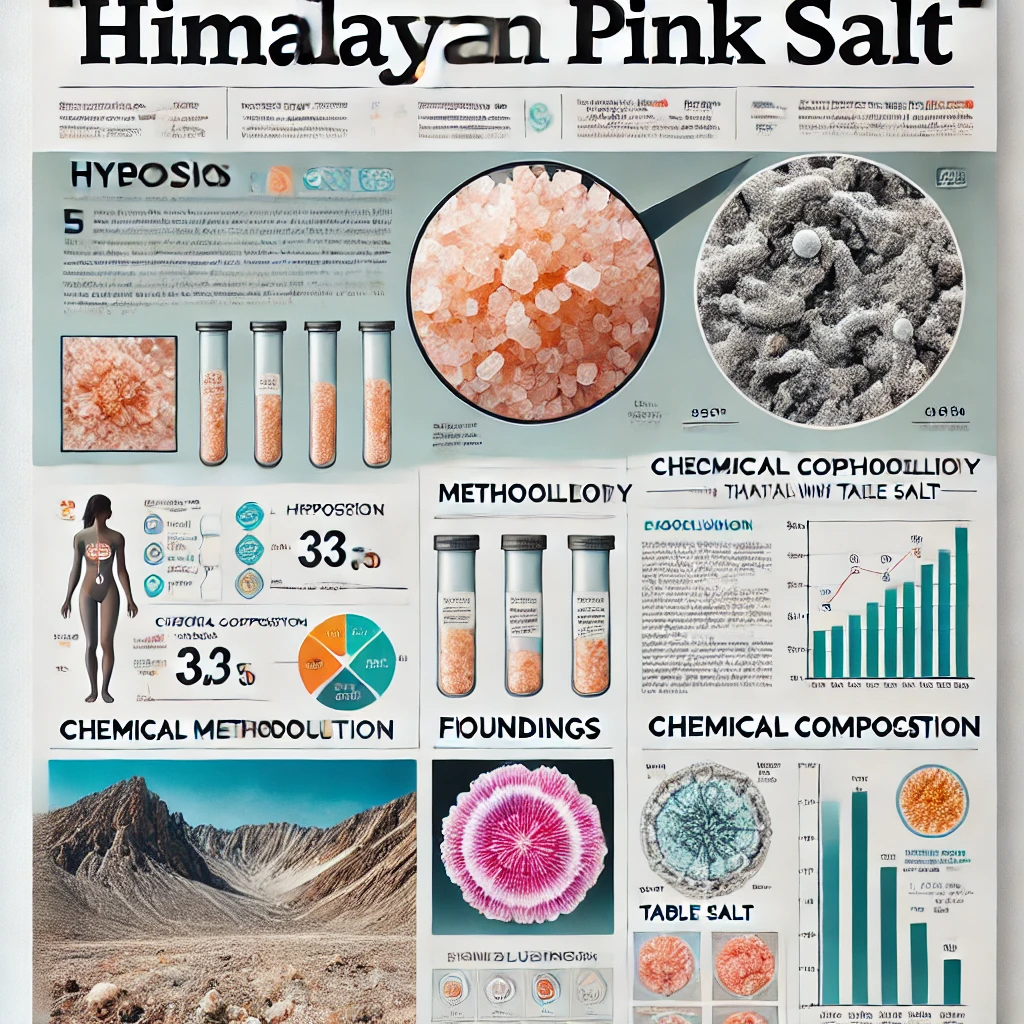Introduction
Himalayan pink salt has gained worldwide popularity for its unique mineral composition and potential health benefits. Sourced from the Khewra Salt Mine in Pakistan, this rock salt is often considered one of the purest salts available. But what makes it scientifically distinct? This article explores the detailed mineral composition, scientific studies, and health implications of Himalayan pink salt.
Origin and Composition
Himalayan pink salt is mined from ancient salt deposits that formed over 250 million years ago due to the evaporation of prehistoric seas. The salt was later buried under lava, which protected it from modern pollution, making it one of the most pristine salt sources on Earth.
Mineral Composition
Himalayan pink salt is unique due to its rich mineral content. While regular table salt is almost 100% sodium chloride (NaCl), Himalayan salt contains around 84 trace minerals and elements. The key components include:
Mineral | Chemical Symbol | Approximate Quantity (ppm) |
Sodium | Na | 368,000 - 380,000 |
Chloride | Cl | 590,000 - 600,000 |
Calcium | Ca | 400 - 1,600 |
Magnesium | Mg | 300 - 700 |
Potassium | K | 2,000 - 3,500 |
Iron | Fe | 0.5 - 50 |
Zinc | Zn | 0.1 - 2 |
Iodine | I | 0.1 - 1.5 |
Copper | Cu | 0.1 - 0.6 |
Manganese | Mn | 0.1 - 1.5 |
Selenium | Se | 0.1 - 0.5 |
Strontium | Sr | 0.1 - 0.2 |
Sulfate | SO4 | 10 - 50 |
Barium | Ba | 0.1 - 1 |
These minerals contribute to its distinctive pink hue, especially iron oxide, which gives it the signature pink color.
Scientific Studies on Himalayan Pink Salt
Several studies have been conducted to understand the health effects of Himalayan pink salt. Some key findings include:
1. Mineral Bioavailability
A study published in the Journal of Trace Elements in Medicine and Biology found that the minerals in Himalayan salt are bioavailable in trace amounts, meaning they can be absorbed by the body in small but beneficial quantities.
2. Electrolyte Balance & Hydration
Research from the American Journal of Clinical Nutrition suggests that natural salts with a mix of sodium, potassium, and magnesium help maintain electrolyte balance more effectively than refined table salt.
3. Effect on Blood Pressure
A comparative study between Himalayan pink salt and table salt published in the European Journal of Nutrition indicated that Himalayan salt may lead to a lower increase in blood pressure when consumed in moderation.
4. Air Purification and Negative Ions
Although many claims exist about Himalayan salt lamps releasing negative ions and purifying the air, scientific studies have provided mixed results. Some research supports mild air purification effects, but large-scale health benefits remain unproven.
Himalayan Pink Salt vs. Table Salt
Feature | Himalayan Pink Salt | Table Salt |
Processing | Naturally harvested, minimally refined | Highly refined, chemically treated |
Mineral Content | 84 trace minerals | Primarily sodium chloride with added iodine |
Additives | None | Anti-caking agents and bleaching chemicals |
Health Benefits | Promotes hydration, electrolyte balance | Excess consumption may contribute to hypertension |
Potential Risks and Considerations
While Himalayan pink salt is a natural and mineral-rich alternative to refined salt, excessive consumption of any type of salt can be harmful. High sodium intake is linked to:
- Hypertension (high blood pressure)
- Kidney Strain
- Water Retention
Additionally, the trace minerals in Himalayan salt are present in small amounts, so it should not be relied upon as a primary source of essential nutrients.
Conclusion
Himalayan pink salt is more than just a culinary trend; it is a naturally occurring mineral-rich salt with potential health benefits. Scientific studies suggest that its minerals contribute to hydration, pH balance, and overall well-being. However, while it may be a better choice than heavily processed table salt, it should still be consumed in moderation. Understanding its mineral composition and scientific background helps in making informed dietary and lifestyle choices.


Hi there to all, for the reason that I am genuinely keen of reading this website’s post to be updated on a regular basis. It carries pleasant stuff.
There is definately a lot to find out about this subject. I like all the points you made
çok yararlı bir paylaşım olmuş teşekkür ederim çok işime yarıcak.
Çok yararlı bi yazı olmuş hocam teşekkür ederim .Sizin yazılarınızı beğenerek okuyorum elinize sağlık.
Pretty! This has been a really wonderful post. Many thanks for providing these details.
Pretty! This has been a really wonderful post. Many thanks for providing these details.
Nice post. I learn something totally new and challenging on websites
This breakfast idea is very practical for families.
Pretty! This has been a really wonderful post. Many thanks for providing these details.
women
This was beautiful Admin. Thank you for your reflections.
Very well presented. Every quote was awesome and thanks for sharing the content. Keep sharing and keep motivating others.
I truly appreciate your technique of writing a blog. I added it to my bookmark site list and will
Perfect random great funny random.
Random amazing crazy nice helpful boring crazy love helpful.